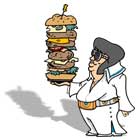|
Do not make a stingy sandwich. Pile the cold cuts high. Customers should see salami coming through the rye.
– Alan Sherman, Sandwiches
Why is November 3, 1718 an important date to remember? Well for one thing, it is the day that John Montagu, the 4th Earl of Sandwich, was born. Who was that, you ask? Well, the next time you bite into a roast beef on rye and think you are eating something as American as apple pie, you would do well to remember that you are mistaken. The sandwich is a British concoction, popularized by this First Lord of the Admiralty who served under Lord North during the American Revolution (1776-81). Also known as "Jemmy Twitcher," a nickname given by his alleged association with pirates, it is he for whom the sandwich bell tolls and for whom it is named.
Why did he do it, you ask? Good question. Eating bread and meat together is probably as old as both bread and meat. Ancient civilizations stuffed their tortillas, pita breads and matzos with a myriad of fillings. John Montagu, however, gave this mode of consumption a new prestige. A notorious gambling man in the court of King George III, he would often travel throughout London from pub to pub on various gambling marathons. He had sliced meat and bread brought to him at the gaming tables so that his hands would be free of grease and he could continue to play as he satisfied his hunger. In 1762 this combination became formally known as the "sandwich." Soon it was a runaway sensation, served frequently at English buffet parties and luncheons.
The Earl had his problems and in later years no sandwich could come to the aid of his failing reputation. Montagu was charged with corruption and blamed for England’s defeat in the Revolutionary War. Some of his fellow patriots held him in contempt, while some historians regarded him as a misunderstood reformer of the English Navy. This ambivalence to his proper place in history is not without ironic undertones. Does it not seem similar to the personal preferences to rare, medium and well-done meats and the many different trappings associated with sandwiches? No? Well…even if you don’t think so, please read on anyway.
In 1827, the sandwich crossed the Atlantic Ocean in what could only have been a very soggy trip. It found its way to America via a cookbook written by Elizabeth Leslie. A recipe for ham sandwiches was suggested as a main dish. The food became immensely popular when soft white bread was introduced to the American diet in the early 1900’s. The sandwich of today has evolved into a versatile, simple and filling meal which is easily adapted to busy life styles.

A sandwich is a personal statement and only as inventive as its creator. It is a reflection of individual taste and judgement for alas, healthy and unhealthy sandwiches co-exist along the same poly-unsaturated plane. (Which category do you think Elvis’s favorite peanut butter and bananas combination falls into? The answer may tell you more about yourself than you are ready to hear.) Some sandwiches are more famous than others, but then, many things are relative and this is a democracy, isn’t it? There’s the Monte Cristo and the Reuben, just to name two cardio-vascular disasters served with a pickle on a plate.
Reuben’s was a landmark New York delicatessen, first established around 1908. Arnold Reuben’s daughter describes a Reuben Special sandwich that was created in 1914 to feed Charlie Chaplin’s hungry leading lady, Annette Seelos. It featured meat, cheese, cole slaw and russian dressing on buttered toasted rye. The Monte Cristo conjures images of men in black cloaks and iron masks fighting with swords one for all and all for one in the struggle for liberté, equalité and fraternité. The fickle finger of history has turned Alexander Dumas’ French Count (and possibly some of his friends as well) into a most delicious but not so heart-healthy combination of half-and-half, currant jelly, eggs, Swiss cheese, ham, confectioner’s sugar and vegetable oil for frying! Go figure!
The sandwich has found a niche in American genre fiction as well. I don’t know what kind of sandwiches Sam Spade, Perry Mason or Phillip Marlowe preferred, but consider Edward X. Delaney, detective extraordinaire, created by the late Lawrence Sanders. He was not only known for the capture of hatchet-wielding psychopaths but also for his unique sandwich combinations. He experimented with exotic breads and onions and meshed them with imported spicy salamis and other cold cuts. The final product was then spread with thin layers of various trappings. Anything that went well with a rye highball and a dill pickle usually sufficed. His sandwich was ready to consume when it was piled so high that he had to eat it hanging over the kitchen sink. (His wife was very neat!)
Despite its relative ease of preparation, making a sandwich involves executive decisions. Not the least of these concerns its very foundation, bread. Shall we white, wrap, whole wheat, rye, sourdough, multi-grain or dance? Man may not live by bread alone, but then again, if variety is the spice of life, he just might be able to swing it. If you make your own bread, you still have to decide which flour to use, reducing your choices by only a few. Now you have the bread. What’s next?
|